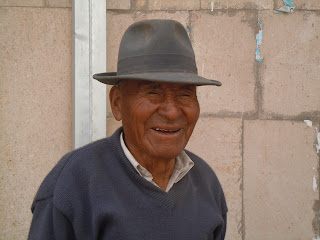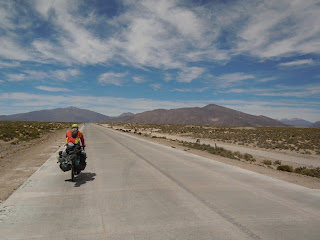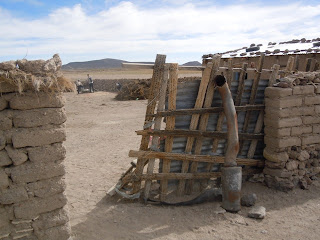the president of Bolivia, Evo Morales, seen on a billboard while leaving La Paz. The first indigenous president of Bolivia, he is known for socialist leanings.
not everyone is happy with Evo
on the way to Oruro, we witnessed a growing moon
this is a somewhat typical Bolivian highway-side town
long stretches of flat riding, seems like a dream after so much climbing and dropping for so many months
getting closer to Oruro
roadside vicuñas, camelid relatives of llamas and alpacas, but not domesticated
the outskirts of Oruro
Oruro as seen from some cliffs above the city
wild sunset above Oruro
The sign says: "Long live Oruro and its general strike!". Yes, we had the dismal luck to be in Oruro during a 72 hour-plus general strike. This is particular to Bolivia it seems... its called "paro", and local communities do this as political statements. Everything shuts down, all roads are blockaded, the streets are empty,and you can barely find enough food to eat. A cyclist's nightmare, really.
demonic painting seen in Oruro's main church
Oruro returns to life after the strike, thankfully, as we have to buy various provisions for the long desert stretches ahead of us...
... buying coca leaves, known to remove effects of altitude sickness, fatigue, and hunger...
buying grain alcohol (stove fuel) in bulk. Apparently Bolivians just drink this stuff.
we discovered this armadillo-back chirongo (!) while guitar shopping in Oruro
this would tax anyone's problem solving abilities. How to get all this onto a bicycle?
fresh-squeezed orange juice vendor
Tom and Jeff ready for battle
the route we would follow from Oruro to Salinas
ominous omen leaving Oruro, there is a dead dog in this pile of garbage. Bolivia seems to have its fair share of scenes like this one.
hitting the open road again, with an absurdly heavy bike
...shortly out of Oruro we ran into flamingoes...
of course the flamingoes only add to the surreal nature of this journey
... surely one of the best parts of cycling in Bolivia is its abundance of abandoned houses, leaving you to wonder where everyone went (answer: mass migration to cities, which explains their hygienic problems and overall chaos). These "casas abandonadas" make for great camping, with windbreaks and often walls and roofs as well. This one came with firewood in the yard, too.
... our digs for an evening and a morning...
...Toledo, which should be a decent town, but instead resembles a ghost town...
this sign, at the entrance to a nearby village, reads: "Warning: all thieves will be burned!"
a hailstorm forced us off the road at this ghost town, whose only inhabitant seemed to be this guy (turns out a few people do live here)
... we didnt realize at this moment that this would be the last green we would see for about a month
... some roadside llamas...
mixed paved/dirt riding towards the cordillera
an enormous herd of llamas backed by snowy peaks
arrvied at Huachacalla, but everything is closed (Sunday). This is typical of Bolivia: either you cycle hours upon hours thinking you will arrive somewhere with some kind of service (lunch, shop, shade, etc.) but more often than not its a ghost town, or a populated town that is deserted and closed up anyway.
friendly local in Huachacalla
a local man in Huachacalla told us we could sleep in his "casa abandonada" up the hill, so we arrived here in late afternoon and spent the night.
... this cat witnessed some serious guitar playing from the window...
this is Sajama, highest peak in Bolivia at 6500m-plus
great wide-open landscapes here
more llamas
Sabaya, our last hope for supplies before hitting the salares (salt flats)
of course, ghost townish as ever. We do however, manage to find bread, water, and some vegetables (turnips and carrots) in Sabaya, as well as bananas (like gold out here)
llamas on the highway
now on dirt, surface of fate for the next several weeks (along with sand)... this is our first view of the Salar de Coipasa
Villa Vitalina as seen from the salt flats
this is truly extraordinary riding, on the surface of bedded pure salt, meters and meters deep everywhere the eye can see
locals gathering salt to sell

on the way to Coipasa village, we ran into deep sand, not the only time we will be seeing this
curious kids in Coipasa
amazing salt crystal formations on the Salar de Coipasa
... we found a cave just at dusk not far from Coipasa village and made ourselves at home...
sunrise above the salar
the cave seen from the salar
riding on in the morning... goal to be off the salar before the sun is too high (we failed)
you gotta try this to believe it
not all smooth-grooving here. These rough salt crystals made for slow going and delayed our progess
also, wet salt made for tricky navigation
Jeff's bottom bracket area while exiting the salar
... arrived in Tauca, by now no surprise that its a ghost town as well, Tom collapses...
actually, Tauca does have a few residents, and they grow lots of quinoa in the lands about
getting water in Luca
... some nice riding here on the way to Salinas...
... cactus blooming, with Salinas in the background below...
we did a lot of resting in Salinas during our two-night stay at the Hostal Ecológico, highly recommended.
this guy, the young son of the owners, would run to the kitchen and bring us back french fries, unbeknownst to his mother. An angel of sorts, hungry cyclist's best friend. We made sure he got his share of candy for these good deeds.
Jeff's sorry bottom lip after the reflective UV on the salar had fried us a few days back























































































2 comments:
The instrument is called Charango :)
http://en.wikipedia.org/wiki/Charango
Jeff and Tom, your great guys! I am getting in nostalgy looking at you pictures. I often made the same experiences as e.g. on the Salar de Coipasa which was so wet to ride. Thanks for all the good documentation.
Swiss Chris on the recumbent, we met in the casa ciclista in chilean patagonia. I think it was called Mañuales
Post a Comment